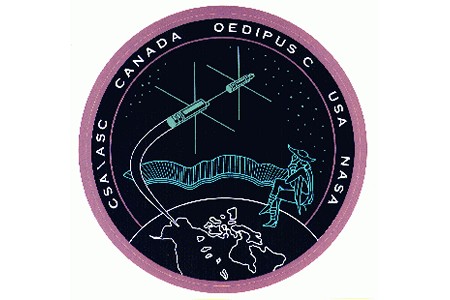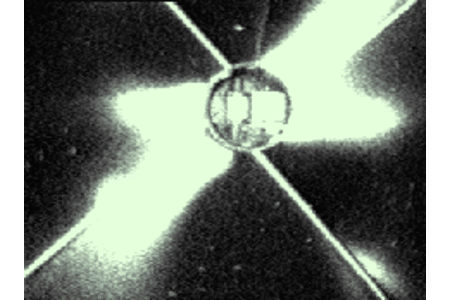OEDIPUS-C Sounding Rocket
Launched successfully November 7, 1995 @ 06:38:18UT
The OEDIPUS-C sounding rocket (Observations of Electric-field Distributions in the Ionospheric Plasma - a Unique Strategy) was launched at 06:38:18 UT on Nov. 7th from from the Poker Flat Research Range near Fairbanks, Alaska. The payload, designed to carry out a number of unique space experiments, was launched to an altitude of 869 km by a Black Brant XII rocket built by Bristol Aerospace, Winnipeg. This collaborative project of CSA and NASA involved more than 20 scientists from Canada and the United States.
OEDIPUS-C was a double payload connected by a conducting wire. The two parts of the spinning double payload separated to a distance of 1.2 km during the sixteen minute flight. A suite of scientific instruments was used to investigate the physics of the upper atmosphere and ionosphere. This equipment included three instruments from the CSA, seven from the National Research Council (NRC), and three others from the University of Saskatchewan and the Phillips Laboratory, U.S.A. Above is an animated sequence of payload separation and conductor cut.
The primary investigation, funded by the CSA's Space Science Program and led by the OEDIPUS C Principal Investigator, Dr. Gordon James of the Communications Research Centre (CRC), involved controlled radio-wave experiments using a transmitter in the forward subpayload and a synchronized receiver in the aft subpayload. Radio science is important to designers of communication services in the Canadian north where the ionosphere can variously refract, absorb or scatter waves. Investigations were also carried out on tether-guided waves, with implications for the electromagnetic compatibility of systems on spacecraft. The radio instruments were built by CAL Corporation and Routes Inc., both of Ottawa.
The particle detectors and magnetometers of OEDIPUS C provided an integrated set of observations of the structure of the aurora. ISR at the University of Calgary contributed two identical Thermal Ion Detectors (TID's) on each sub-payload. These instruments measured positively-charged ions at 90 deg pitch angle in the 0-20 eV range, and also auroral electrons at 45 and 90 deg pitch angle in the 0.2-20 keV range. Complete energy and angular electron distributions and wave-particle correlations were made by the Phillips Laboratories Energetic Particle Instruments (EPI). The aurora is an important indicator of the remote interaction of the interplanetary gas with the earth's upper atmosphere. Finally, a space-mechanics instrument called the Tether Force Sensor provided novel insights into the complicated dynamic motion of the tethered double payload.
OEDIPUS-C Science Team
| Team Member | Institution |
|---|---|
| D.A. Hardy (Instrumenter) | Phillips Lab |
| A.M. Jablonski (Instrumenter) | CSA/STP |
| J.A. Koehler (Instrumenter) | U. Saskatchewan |
| D.J. Knudsen (Instrumenter) | NRCC/HIA |
| D.D. Wallis (Instrumenter) | NRCC/HIA |
| K.G. Balmain | U. of Toronto |
| R.F. Benson | NASA/GSFC |
| W. Calvert | U. Iowa |
| F. Creutzberg | NRCC/HIA |
| R.P.S. Han | U. Manitoba |
| G.W. Hulbert | York U. |
| R. Koehler | York U. |
| J.G. Laframboise | York U. |
| A.E. Luettgen | U. of Toronto |
| J.W. MacDougall | U. Western Ontario |
| D. Olson | Phillips Lab |
| P. Prikryl | CRC |
| G. Tyc | Bristol Aerospace |
| F.R. Vigneron | CSA/STP |
| B.A. Whalen | NRCC/HIA |
UofC Publications
Bock, B.J.J ., Study of Lower-Hybrid Cavities Detected by the GEODESIC and OEDIPUS-C Sounding Rockets, MSc Thesis, University of Calgary, March 2005.
Knudsen, D. J., B. J. J. Bock, S. R. Bounds, J. K. Burchill, J. H. Clemmons, J. D. Curtis, A. I. Eriksson, M. E. Koepke, R. F. Pfaff, D. D. Wallis, and N. Whaley, Lower-hybrid cavity density depletions as a result of transverse ion acceleration localized on the gyroradius scale, J. Geophys. Res., 109, A04212, doi:10.1029/2003JA010089, 2004.
Franchuk, S., OEDIPUS-C observations of auroral field-aligned currents, MSc thesis, September 2000.
Prikryl, P., H.G. James, D.J. Knudsen, S.C. Franchuk, H.C. Stenbaek-Nielsen, and D.D. Wallis, OEDIPUS-C topside sounding of a structured auroral E region, J. Geophys. Res., 105, 193, 2000.
Knudsen, D.,J., D.D. Wallis, and H.G. James, Tethered Two-Point Observations of Solitary Auroral Density Cavities, Geophys. Res. Lett, 26, 2933, 1999
Prikryl, P., H.G. James, and D.J. Knudsen, OEDIPUS-C topside sounding of an auroral E-region, Adv. Space Res., Vol 24/8, 1065, 1999.

